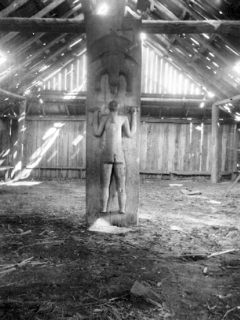 W
WBigfoot, also commonly referred to as Sasquatch, is an ape-like creature that is purported to inhabit the forests of North America. A prominent subject within Canadian and American folklore, supposed evidence of the existence of Bigfoot includes a number of anecdotal visual sightings as well as disputed video and audio recordings, photographs, and casts of large footprints. Some of these are speculated or known to be hoaxes. Bigfoot has become an icon within the fringe subculture of cryptozoology and an enduring element of popular culture.
 W
WCoast Salish art is an art unique to the Pacific Northwest Coast among the Coast Salish peoples. Coast Salish are peoples from the Pacific Northwest Coast made up of many different languages and cultural characteristics. Coast Salish territory covers the coast of British Columbia and Washington state. Within traditional Coast Salish art there are two major forms; the flat design and carving, and basketry and weaving. In historical times these were delineated among male and female roles in the community with men made "figurative pieces, such as sculptures and paintings that depicts crest, shamanic beings, and spirits, whereas women produced baskets and textiles, most often decorated with abstract designs."
 W
WThe Doug flag, also referred to as the Cascadian flag or the Cascadia Doug flag and nicknamed "Old Doug" or simply "the Doug", is one of the primary symbols and an unofficial flag of the Cascadia bioregion, which roughly encompasses the U.S. states of Oregon, Idaho, and Washington, the Canadian province of British Columbia, and other parts of North America's Pacific Northwest. It was designed by Portland, Oregon native Alexander Baretich in the academic year of 1994–1995. It is named after the Douglas fir, featured on the flag.
 W
WEd, Edd n Eddy's Big Picture Show is a 2009 animated adventure comedy television film based on the animated series Ed, Edd n Eddy, serving as the series finale. It was produced by a.k.a. Cartoon and premiered on Cartoon Network on November 8, 2009. The film was directed by series creator Danny Antonucci, who co-wrote the film with Jono Howard, Mike Kubat, Rachel Connor, and Stacy Warnick. Big Picture Show centers on the Eds' journey to find Eddy's unnamed older brother after their most recent scam leaves the Peach Creek Cul-de-Sac in a state of devastation.
 W
WThe San Juan River is a river that flows from east to west through southern Vancouver Island in British Columbia, Canada. The river originates in the Seymour Range, flows westward through the San Juan Valley to Port San Juan at Port Renfrew.
 W
WJolly Jack's Lost Mine is a legend about a hidden placer mine supposed to be located in the Boundary Country of British Columbia. The mine has been written about by local historians and various magazines. Many have searched for the lost placer mine of Jolly Jack. It is a local legend in the Boundary Country.
 W
WThe Kamloops Wawa was a newspaper published by Father Jean-Marie-Raphaël Le Jeune, superior of the Roman Catholic Diocese of Kamloops in British Columbia, Canada, beginning May 25, 1891, and continuing into the 1900s. The contents of the Kamloops Wawa were near-entirely written using Le Jeune's adaptation of the French Duployan shorthand writing system. Most of the texts of the Kamloops Wawa were composed in the local variant of Chinook Jargon with some passages and articles in Nlaka'pamuxtsin, Secwepmectsin, St'at'imcets and other traditional languages. Some series of articles, however, included translations into Chinook Jargon of classical texts from Latin, such as the Seven Kings of Rome, though most content was either community news or translations of the mass or other liturgical materials.
 W
WKwakwaka'wakw art describes the art of the Kwakwaka'wakw peoples of British Columbia. It encompasses a wide variety of woodcarving, sculpture, painting, weaving and dance. Kwakwaka'wakw arts are exemplified in totem poles, masks, wooden carvings, jewelry and woven blankets. Visual arts are defined by simplicity, realism, and artistic emphasis. Dances are observed in the many rituals and ceremonies in Kwakwaka'wakw culture. Much of what is known about Kwakwaka'wakw art comes from oral history, archeological finds in the 19th century, inherited objects, and devoted artists educated in Kwakwaka'wakw traditions.
 W
WCamp McKinney is a ghost town in the Boundary Country region of British Columbia, Canada. It is located southeast of Mount Baldy, northeast of Osoyoos.
 W
WIn Canadian folklore, the Ogopogo is a lake monster said to inhabit Okanagan Lake in British Columbia, Canada. Some scholars have charted the entity's development from First Nations folklore and widespread water monster folklore motifs. The Ogopogo now plays a role in the commercial symbolism and media representation of the region.
 W
WPitt Lake's Lost Gold Mine is a legendary lost mine said to be near Pitt Lake, British Columbia, Canada, the supposed wealth of which has held the imagination of people worldwide for more than a century. Ever since the years of the Fraser Canyon Gold Rush prospectors and adventurers have been looking for the mine and gold-rush rumors have evolved into legends repeated and enriched over time. The mysterious riches are known as Slumach’s Lost Mine, or Lost Creek Mine.
 W
WThe Thetis Lake Monster is a legendary creature and admitted hoax of Victoria, British Columbia, Canada. In 1972, two teenage boys claimed to see a monster emerge from Thetis Lake beach. The description of the creature that the teenagers gave matched the description of the Gill-man from the 1954 movie Creature from the Black Lagoon.